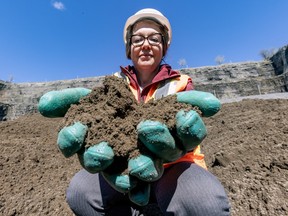Once landfilled and ignored, the city’s incinerated sewage sludge is now prized for its fertility.

At the bottom of a vast quarry 40 stories deep in east Montreal resides the end product of all our end products.
The residue of all the waste that is flushed into our sewage systems is treated at Montreal’s gargantuan filtration plant and then incinerated at 840 degrees C until only an earthen ash remains. For decades, it was dumped in a landfill and forgotten, slowly taken over by grasses and trees where foxes hunt and birds nest.
Then chemists deduced there was a form of gold to be found in the leftovers, known as sewage sludge ash — phosphorous, a nutrient rich fertilizer that helps roots to grow, plants to mature and seeds to develop. In 2016, the city received certification from the Canadian Food Inspection Agency that would allow its sludge to be spread on farmers’ fields.
“Developing this is important, because we’re replacing chemical fertilizers that have to be produced in factories,” said Carole Fleury, head of processes and laboratories at the Jean-R.-Marcotte wastewater plant. “This is a natural fertilizer that’s rich in phosphorous. If we didn’t use this, we would just lose it.”


The city is not paid for the nutrient-rich mud, which can have anywhere from 1.4 per cent to 3.2 per cent phosphorous content and is branded under the name “Fertili Cendres” or “Ash Fertilizer.” It hires a waste fertilizer management firm, which picks up the ashes and sells them to farmers. Doing so cuts down on the landfill dumping fees the city has to pay under Quebec environmental regulations, but ultimately shipping it is more expensive than landfilling it.
“It’s part of the city’s mission to find value in its waste products,” Fleury said.


André Vezeau has been the site manager of the massive pit he calls “my sandbox” for 21 years. His sandbox, 700 metres long and over 100 metres deep, was formerly owned and operated by the Demix corporation, which mined it for gravel and other aggregates mainly used to make concrete. Now its bottom is lined with what Vezeau refers to as a “club sandwich” of protective layers — one metre of clean gravel, to allow water to leach out of the ashen waste; geotextile fabric to stop the dirt from trickling into the gravel; and a metre-thick layer of clay, to form as a sort of solid barrier.
He conducts the dump trucks that come in to deposit the ashes from the wastewater plant five kilometres away, as they slowly roll their way to the bottom of the quarry to dump their loads. In winter, when the serpentine roads are made treacherous by snow or ice, there is an emergency chute where they can discharge their ashes from the top of the quarry. By season’s end, the mound towers nearly to the quarry’s lip. It will be shovelled out and transferred to the bottom in the spring and summer.
Early spring is the trickiest time, when the top three feet of ashen earth that has frozen is exposed to the warming sun and turns into a “royal field of mud.”
Trucks can and do get stuck. Worse still, a 45-foot-long dump truck with its bucket in the air is an unstable beast, requiring a solid footing to ensure it doesn’t tip over. Bulldozers and trucks roll back and forth, constantly levelling and compacting the soil.

In another section are mounds of sand, leftovers from the abrasives spread in the winter that get swept into the sewage system. Because the sand can’t be incinerated, and it’s tainted with wastewater as well as contaminants that include credit cards, razor blades and dentures, it’s piled in a separate section of the quarry.
After more than 30 years at Jean-R.-Marcotte, Vezeau is anticipating his coming retirement. But he sounds as though he will miss his sandpit. When he first inherited it, it was covered in trash.
“It took three years to clean all that out,” he said. “I had to train the drivers not to throw their garbage out the windows.”
Now, despite its vocation as a dump for humans’ waste, the site is pristine and odour-free. And where once its contents symbolized the end, ashes to ashes, dust to dust, now they’re being sent back to help begin again, fertilizing the earth’s bounty from whence they came for future generations.
Vezeau’s boss came to him 20 years ago and offered him the choice of a job in the plant, or to be the manager of a vast pit in the earth in Montreal East. He chose the sandbox, and never regretted it.
“It’s peaceful down here,” he said, in the shade of the trees that have grown from the ashes, birdsong mingling with the soft growl of dump trucks crawling over the dirt.
“It feels calm.”